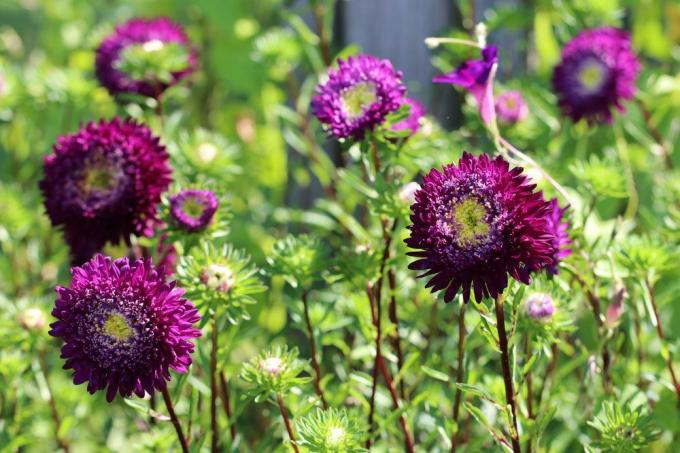
table of contents
- Summer aster: hardy?
- Herbstaster: hardy?
- Hibernate asters
- Cut
- Winter protection
Whether in the garden or in pots, asters are among the most popular garden plants in Germany. The daisy family inspire with their intense leaf green and their flowers, which, depending on the species, vary from May to November show and the possibility of planting them directly in the field or on the balcony or terrace place. Interested parties ask themselves whether the summer asters and autumn asters are hardy and suitable for German gardens.
Summer aster: hardy?
At the summer aster (bot. Callistephus chinensis) is the only taxon of the genus Callistephus and therefore does not belong to the genus of the actual asters. Nevertheless, it is counted to the same tribe, Astereae. It is also known as the garden aster and comes from East Asia, more precisely Japan, Korea and China. Compared to other asters are summer asters not hardy, because they are annual plants that, despite their robust construction, only survive one season. The classic summer season schedule of the summer stars as follows:
- Sow outdoors in mid-May
- can be brought forward at home in mid-March
- Germination time: up to 4 weeks
- Flowering period: August to the end of October
- seeds can be collected after flowering
- then the aster dies
There is nothing more to consider with the summer asters. It does not matter which varieties of the species it is, because these are only more robust or have particularly large flowers. However, the flowering times differ a little, so you can extend the flowering time of the plants. The cycle mentioned above also applies to specimens that are kept in pots, because the daisy family does not develop any persistent organs and uses all its strength to form flowers. However, you can delay flowering and keep the above-ground parts of the plant longer:
- The location should be protected from the wind
- Cover the plant with fleece or jute
For example, house walls and places under roofs that protect the asters from cold winds have become established. Balconies are usually not recommended. These are often quite warm, but exposed to the wind without mercy.

tip: Callistephus chinensis is typically susceptible to aster wilt, in which fungi block the absorption and transmission of moisture within the plant. For this reason, you should never sow summer asters in the same place in the garden to prevent possible infection, as a change of location works effectively against the fungi in the soil.
Herbstaster: hardy?
Compared to summer asters, you can look forward to hardy asters with autumn asters. However, you have to be careful here, because the term Herbstaster refers to different types of asters of the genera Aster and Symphyotrichum. These are plants that develop rhizomes as persistence organs and thus survive the winter. They come mainly from North America and Asia. The flowering period of the plants extends into late autumn, which has earned them the nickname “autumn asters”.

The following species are usually meant, whose winter hardiness is specified with the corresponding winter hardiness zone (WHZ or Z):
- Raublatt-Aster (bot. Symphyotrichum novae-angliae): Z2 (-45.5 ° C to -40.1 ° C)
- Smooth-leaf aster (bot. Symphyotrichum novi-belgii): Z2 (-45.5 ° C to -40.1 ° C)
- Pillow aster (Symphyotrichum dumosum): Z3 (-40.1 ° C to -34.5 ° C)
- Erika aster (bot. Symphyotrichum ericoides): Z3 (-40.1 ° C to -34.5 ° C)
- Asiatic wild aster (bot. Aster ageratoides): Z7 (-17.8 ° C to -12.3 ° C)
This is only a small overview of the diversity of the genera, because Symphyotrichum alone has numerous taxa that have a similar winter hardiness. Of the more than 90 species, the four named have established themselves most strongly as garden plants in Central Europe and can be planted without any problems. For this reason, it is very likely that you will find these most frequently in stores.
Hibernate asters
Among the species of the genus Aster, it is the wild aster that is suitable as an autumn plant and inspires with its flowering from September to the end of October. The best: all autumn asters receive the same winter protection outdoors, which makes keeping them easier:
Cut
Do not cut back the asters in the fall. Although the plants are hardy, it is necessary that they have sufficient plant material so that the root ball is protected. The dried leaves and flowers, which can be easily cut back in the following spring, are best for this. In addition, the dried up parts of the plant create a picturesque look in wintry gray.
Winter protection
Soil enriched with compost is suitable as good winter protection for the asters. Since asters are very hungry, the compost ensures a sufficient supply of nutrients over the winter so that the plants can sprout again immediately after winter and can be cut. Spread the fresh compost thoroughly around the asters' root balls so that they are well covered.
Finally, a layer of sticks follows. Brushwood is a good winter protection, especially for the Asian wild asters, as they need more protection than the Symphyotrichum asters. You can be a little generous when distributing the brushwood.

If you have decided on asters in the tub, you definitely need to provide winter protection, as it is not recommended to bring the plants indoors over the winter. However, since the pot can easily freeze through, it needs a new location:
- Light requirement: bright
- southern orientation
- The balcony and house walls are well suited
- sheltered from the wind
If you live in a region where it rains a lot, you should also place the potted plants in a location protected from precipitation. But that means that you have to take care of the watering yourself over the winter.



